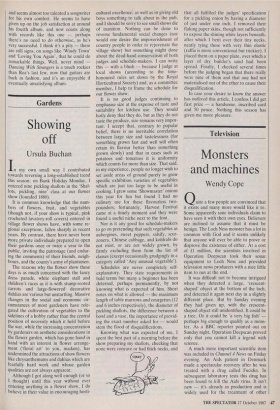Gardens
Showing off
Ursula Buchan
In my own small way I contributed towards reversing a long-established trend this season: on Bank Holiday Monday, I entered nine pickling shallots in the 'Shal- lots, pickling, nine' class at our flower show (founded 1880).
It is common knowledge that the num- bers of flowers, fruit, and vegetables (though not, if your show is typical, pink crocheted lavatory-roll covers) entered in village flower shows have, with some re- gional exceptions, fallen sharply in recent years. By contrast, there have never been more private individuals prepared to open their gardens once or twice a year to the public, inviting the patronage (and endur- ing the comments) of their friends, neigh- bours, and the county's army of plantsmen.
The reasons why the flower show these days is as much concerned with the fancy dress parade, white elephant stall and children's races as it is with stump-rooted carrots and large-flowered decorative dahlias are various but unstartling. Massive changes in the social and economic cir- cumstances of most gardeners have rele- gated the cultivation of vegetables to the Sidelines of a hobby rather than the central position of necessity which it held before the war, while the increasing concentration by gardeners on aesthetic considerations in the flower garden, which has gone hand in hand with an interest in flower arrange- ment ('floral art' to you, madam), has undermined the attractions of show flowers like chrysanthemums and dahlias which are fearfully hard work and whose garden qualities are not always apparent.
Although I got along well enough (or so I thought) until this year without ever entering anything in a flower show, I do believe in their value in encouraging horti- cultural excellence), as well as in giving old boys something to talk about in the pub, and I should be sorry to see small shows die of inanition. Nothing can be done to reverse fundamental social changes (nor would one desire the impoverishment of country people in order to rejuvenate the village show) but something might done about the dead-hand conservatism of both judges and schedule-makers. I can write this — with a blush — because I judge at local shows (according to the time- honoured rules set down by the Royal Horticultural Society) and, as a committee member, I help to frame the schedule for our flower show.
It is no good judges continuing to emphasise size at the expense of taste and suitability for kitchen use. They would hotly deny that they do, but as they do not taste the produce, size remains very impor- tant. I accept that, contrary to popular belief, there is no inevitable correlation between large size and tastelessness (for something grown fast and well will often retain its flavour better than something grown slowly) and that in cases such as potatoes and tomatoes it is uniformity which counts far more than size. That said, in my experience, people no longer wish to set aside areas of ground purely to grow specific exhibition varieties of vegetables which are just too large to be useful in cooking. I grew some `Showmaster' onions this year for fun but found I had no culinary use for these flavourless two- pounders; fortunately, Harvest Festival came at a timely moment and they were found a useful niche next to the font.
Nor is it any good for schedule-makers to go on pretending that such vegetables as aubergines, sweet peppers, salsify, scor- zonera, Chinese cabbage, and kohlrabi .do not exist, or are not widely grown, by firmly excluding them from the list of classes (except occasionally grudgingly in a category called 'Any unusual vegetable').
Schedules are never completely self- explanatory. They state requirements in bald terms but many a beginner has been deterred, perhaps permanently, by not knowing what is expected of him. Short notes on what is allowed — the maximum length of table marrows and courgettes (12 and 6 inches respectively), the diameter of pickling shallots, the difference between a bowl and a vase, the importance of provid- ing the exact number asked for — would stem the flood of disqualifications.
Knowing what was expected of me, I spent the best part of a morning before the show preparing my shallots, checking that none were concave or had thick necks, and that all fulfilled the judges' specification for a pickling onion by having a diameter of just under one inch. I removed their flaking paper skins, though not sufficiently to expose the shining white layers beneath, after which I bent over their tiny necks, neatly tying these with very thin elastic (raffia is more conventional but trickier). I placed them on a paper plate, over which a layer of dry builder's sand had been spread. Finally, I checked several times before the judging began that there really were nine of them and that one had not materialised out of the ether to cause their disqualification.
In case your desire to know the answer has outlived this article, I confess I did get first prize — a handsome, inscribed card and 50 pence. Nothing this season has given me more pleasure.


























































 Previous page
Previous page